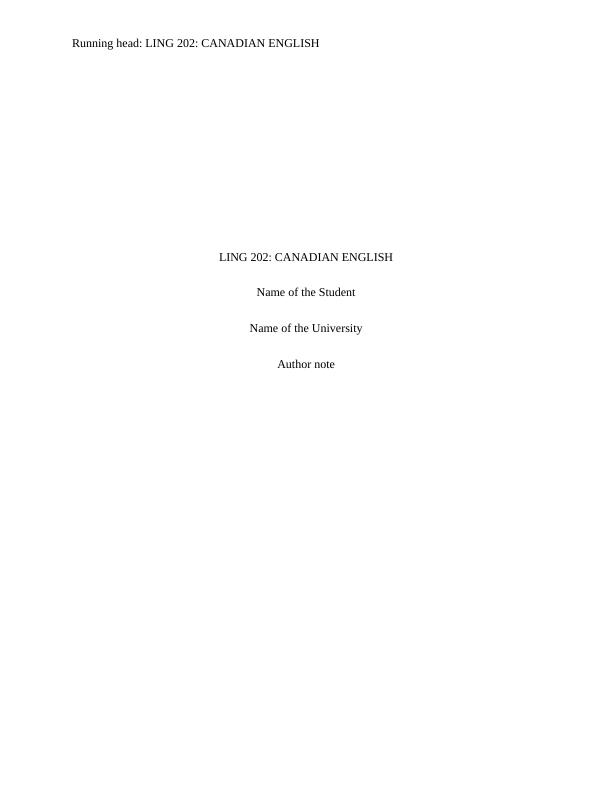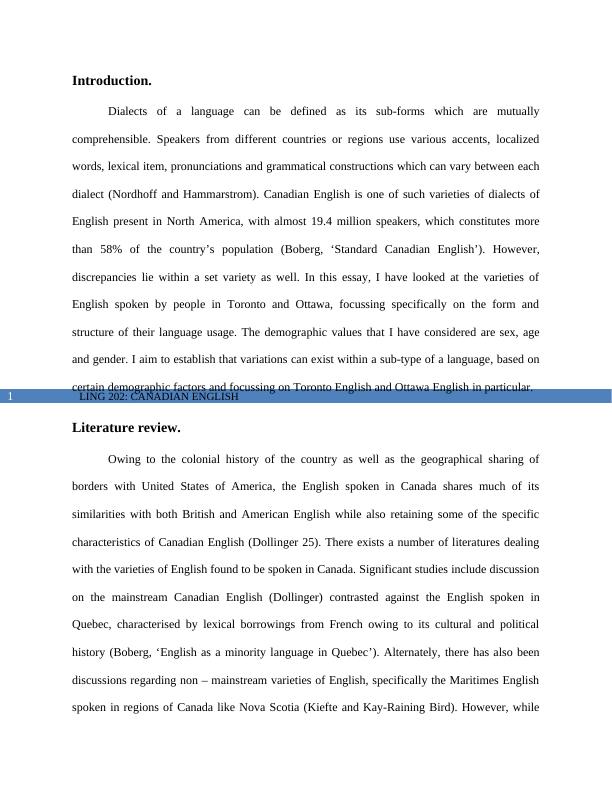LING202 Canadian English Case Study 2022
Added on 2022-09-26
8 Pages1381 Words23 Views
Running head: LING 202: CANADIAN ENGLISH
LING 202: CANADIAN ENGLISH
Name of the Student
Name of the University
Author note
LING 202: CANADIAN ENGLISH
Name of the Student
Name of the University
Author note

LING 202: CANADIAN ENGLISH1
Introduction.
Dialects of a language can be defined as its sub-forms which are mutually
comprehensible. Speakers from different countries or regions use various accents, localized
words, lexical item, pronunciations and grammatical constructions which can vary between each
dialect (Nordhoff and Hammarstrom). Canadian English is one of such varieties of dialects of
English present in North America, with almost 19.4 million speakers, which constitutes more
than 58% of the country’s population (Boberg, ‘Standard Canadian English’). However,
discrepancies lie within a set variety as well. In this essay, I have looked at the varieties of
English spoken by people in Toronto and Ottawa, focussing specifically on the form and
structure of their language usage. The demographic values that I have considered are sex, age
and gender. I aim to establish that variations can exist within a sub-type of a language, based on
certain demographic factors and focussing on Toronto English and Ottawa English in particular.
Literature review.
Owing to the colonial history of the country as well as the geographical sharing of
borders with United States of America, the English spoken in Canada shares much of its
similarities with both British and American English while also retaining some of the specific
characteristics of Canadian English (Dollinger 25). There exists a number of literatures dealing
with the varieties of English found to be spoken in Canada. Significant studies include discussion
on the mainstream Canadian English (Dollinger) contrasted against the English spoken in
Quebec, characterised by lexical borrowings from French owing to its cultural and political
history (Boberg, ‘English as a minority language in Quebec’). Alternately, there has also been
discussions regarding non – mainstream varieties of English, specifically the Maritimes English
spoken in regions of Canada like Nova Scotia (Kiefte and Kay-Raining Bird). However, while
Introduction.
Dialects of a language can be defined as its sub-forms which are mutually
comprehensible. Speakers from different countries or regions use various accents, localized
words, lexical item, pronunciations and grammatical constructions which can vary between each
dialect (Nordhoff and Hammarstrom). Canadian English is one of such varieties of dialects of
English present in North America, with almost 19.4 million speakers, which constitutes more
than 58% of the country’s population (Boberg, ‘Standard Canadian English’). However,
discrepancies lie within a set variety as well. In this essay, I have looked at the varieties of
English spoken by people in Toronto and Ottawa, focussing specifically on the form and
structure of their language usage. The demographic values that I have considered are sex, age
and gender. I aim to establish that variations can exist within a sub-type of a language, based on
certain demographic factors and focussing on Toronto English and Ottawa English in particular.
Literature review.
Owing to the colonial history of the country as well as the geographical sharing of
borders with United States of America, the English spoken in Canada shares much of its
similarities with both British and American English while also retaining some of the specific
characteristics of Canadian English (Dollinger 25). There exists a number of literatures dealing
with the varieties of English found to be spoken in Canada. Significant studies include discussion
on the mainstream Canadian English (Dollinger) contrasted against the English spoken in
Quebec, characterised by lexical borrowings from French owing to its cultural and political
history (Boberg, ‘English as a minority language in Quebec’). Alternately, there has also been
discussions regarding non – mainstream varieties of English, specifically the Maritimes English
spoken in regions of Canada like Nova Scotia (Kiefte and Kay-Raining Bird). However, while

LING 202: CANADIAN ENGLISH2
these are minority languages as described in the publications, the English spoken in larger cities
like Toronto and Ottawa are expected to follow certain restrictions and conditions that make
them different from the so called ‘ethnic varieties’. In majority of the cases, the factors affecting
language use in a region influenced by cross cultural and cross linguistic contact, include
language transfer. In a study on the ethnic orientation and linguistic variation of English in
Toronto, done by Hoffman and walker, the authors state, “our analysis of two sociolinguistic
variables shows that speakers may vary in overall rate, but linguistic conditioning remains
largely constant across and within ethnic groups. Whereas there is evidence for language
transfer in the first generation, differences between generations suggest that transfer does not
persist” (37). This shows that irrespective of the restrictions posed by cross lingual transfers,
ethnic and demographic factors play a significant role in modulating the way language is used in
certain communicative situations.
Methodology.
For conducting this qualitative study, I recruited 10 speakers from Toronto and Ottawa. I
also selected three social variables for the study – sex (Male and Female), geographical location
(Toronto or Ottawa) and age (Young, middle aged or Old). Table 1 shows their distribution in
terms of the variables.
I tested the participants based on their choice of lexicon, phonological preference,
perception of rhyme and choice of syntax. The responses were provided to them in the form of
multiple choices or simple yes/no responses, and were encoded in terms of percentage of
participants who responded with a specific answer. Restricting the responses to choices made it
easier for me to encode them but that required knowing the exact responses that is normally
found in Canadian English.
these are minority languages as described in the publications, the English spoken in larger cities
like Toronto and Ottawa are expected to follow certain restrictions and conditions that make
them different from the so called ‘ethnic varieties’. In majority of the cases, the factors affecting
language use in a region influenced by cross cultural and cross linguistic contact, include
language transfer. In a study on the ethnic orientation and linguistic variation of English in
Toronto, done by Hoffman and walker, the authors state, “our analysis of two sociolinguistic
variables shows that speakers may vary in overall rate, but linguistic conditioning remains
largely constant across and within ethnic groups. Whereas there is evidence for language
transfer in the first generation, differences between generations suggest that transfer does not
persist” (37). This shows that irrespective of the restrictions posed by cross lingual transfers,
ethnic and demographic factors play a significant role in modulating the way language is used in
certain communicative situations.
Methodology.
For conducting this qualitative study, I recruited 10 speakers from Toronto and Ottawa. I
also selected three social variables for the study – sex (Male and Female), geographical location
(Toronto or Ottawa) and age (Young, middle aged or Old). Table 1 shows their distribution in
terms of the variables.
I tested the participants based on their choice of lexicon, phonological preference,
perception of rhyme and choice of syntax. The responses were provided to them in the form of
multiple choices or simple yes/no responses, and were encoded in terms of percentage of
participants who responded with a specific answer. Restricting the responses to choices made it
easier for me to encode them but that required knowing the exact responses that is normally
found in Canadian English.

End of preview
Want to access all the pages? Upload your documents or become a member.
Related Documents
African Nova Scotian English Article 2022lg...
|6
|1252
|21